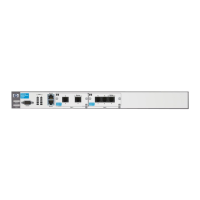14-112
Using the Web Browser Interface for Basic Configuration Tasks
Bridging
Configuring the Spanning Tree Protocol
Typically, RSTP will run on your WAN without any further configurations.
However, you can:
■ view information about the spanning tree
■ configure the router to run the legacy version, STP, rather than RSTP
■ change the router’s bridge priority
■ alter spanning tree timers
■ configure properties for individual interfaces
Viewing a Spanning Tree
RSTP and STP prune connections in a looped topology. All nodes participating
in the same bridge group generate a shared, loopless topology. You can view
information about this topology, called a spanning tree instance. Follow
these steps:
1. Select Spanning Tree under Router/Bridge in the navigation bar.
2. Scroll down to the Spanning Tree Properties window and select the
Spanning Tree Instance that you want to view.
3. A window, such as the one displayed in Figure 14-82, will display informa-
tion that you can view to determine:
• Which network device is the root.
• Which interfaces are forwarding packets.
• Which interfaces have been disabled—for example, in Figure 14-82
the Frame Relay 1.102 subinterface provides a redundant connection
to the root, so its role is “Blocking” and it does not forward packets.
• Which interface role each interface is playing—Root ports are on the
best path to the root device. Designated ports connect to root ports
on neighbors further from the root. Edge ports connect to end
devices. For example, in Figure 14-82, the Ethernet 0/2 interface
connects the local device to the root, and the Ethernet 0/1 interface
provides a connection to the root for a connected network.
The Spanning Tree Properties “STP <instance number>” window dis-
plays information about the root bridge in the Root ID column and the
local device in the Bridge ID column. For example, in Figure 14-82, the
root is identified by its MAC address 00:12:79:05:25:D4, and it is connected
to the local router through the Ethernet 0/2 interface.

